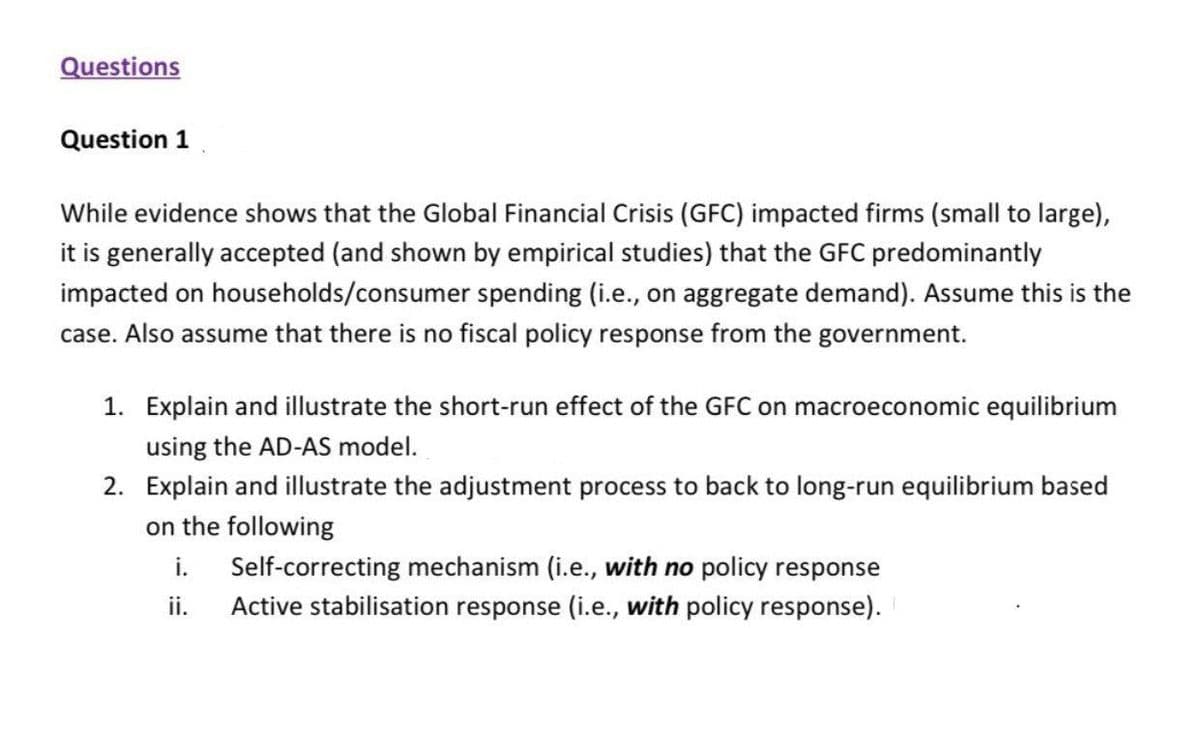While evidence shows that the Global Financial Crisis (GFC) impacted firms (small to large), it is generally accepted (and shown by empirical studies) that the GFC predominantly impacted on households/consumer spending (i.e., on aggregate demand). Assume this is the case. Also assume that there is no fiscal policy response from the government. 1. Explain and illustrate the short-run effect of the GFC on macroeconomic equilibrium using the AD-AS model. 2. Explain and illustrate the adjustment process to back to long-run equilibrium based on the following Self-correcting mechanism (i.e., with no policy response i. ii. Active stabilisation response (i.e., with policy response).
While evidence shows that the Global Financial Crisis (GFC) impacted firms (small to large), it is generally accepted (and shown by empirical studies) that the GFC predominantly impacted on households/consumer spending (i.e., on aggregate demand). Assume this is the case. Also assume that there is no fiscal policy response from the government. 1. Explain and illustrate the short-run effect of the GFC on macroeconomic equilibrium using the AD-AS model. 2. Explain and illustrate the adjustment process to back to long-run equilibrium based on the following Self-correcting mechanism (i.e., with no policy response i. ii. Active stabilisation response (i.e., with policy response).
Economics: Private and Public Choice (MindTap Course List)
16th Edition
ISBN:9781305506725
Author:James D. Gwartney, Richard L. Stroup, Russell S. Sobel, David A. Macpherson
Publisher:James D. Gwartney, Richard L. Stroup, Russell S. Sobel, David A. Macpherson
Chapter12: Fiscal Policy, Incentives, And Secondary Effects
Section: Chapter Questions
Problem 13CQ
Related questions
Question
Please And My Question 1 no 2 and sub part i & ii please no reject thank U....

Transcribed Image Text:Questions
Question 1
While evidence shows that the Global Financial Crisis (GFC) impacted firms (small to large),
it is generally accepted (and shown by empirical studies) that the GFC predominantly
impacted on households/consumer spending (i.e., on aggregate demand). Assume this is the
case. Also assume that there is no fiscal policy response from the government.
1. Explain and illustrate the short-run effect of the GFC on macroeconomic equilibrium
using the AD-AS model.
2. Explain and illustrate the adjustment process to back to long-run equilibrium based
on the following
Self-correcting mechanism (i.e., with no policy response
i.
ii.
Active stabilisation response (i.e., with policy response).
Expert Solution
This question has been solved!
Explore an expertly crafted, step-by-step solution for a thorough understanding of key concepts.
Step by step
Solved in 4 steps with 3 images

Knowledge Booster
Learn more about
Need a deep-dive on the concept behind this application? Look no further. Learn more about this topic, economics and related others by exploring similar questions and additional content below.Recommended textbooks for you

Economics: Private and Public Choice (MindTap Cou…
Economics
ISBN:
9781305506725
Author:
James D. Gwartney, Richard L. Stroup, Russell S. Sobel, David A. Macpherson
Publisher:
Cengage Learning

Macroeconomics: Private and Public Choice (MindTa…
Economics
ISBN:
9781305506756
Author:
James D. Gwartney, Richard L. Stroup, Russell S. Sobel, David A. Macpherson
Publisher:
Cengage Learning


Economics: Private and Public Choice (MindTap Cou…
Economics
ISBN:
9781305506725
Author:
James D. Gwartney, Richard L. Stroup, Russell S. Sobel, David A. Macpherson
Publisher:
Cengage Learning

Macroeconomics: Private and Public Choice (MindTa…
Economics
ISBN:
9781305506756
Author:
James D. Gwartney, Richard L. Stroup, Russell S. Sobel, David A. Macpherson
Publisher:
Cengage Learning


Brief Principles of Macroeconomics (MindTap Cours…
Economics
ISBN:
9781337091985
Author:
N. Gregory Mankiw
Publisher:
Cengage Learning

Essentials of Economics (MindTap Course List)
Economics
ISBN:
9781337091992
Author:
N. Gregory Mankiw
Publisher:
Cengage Learning

Exploring Economics
Economics
ISBN:
9781544336329
Author:
Robert L. Sexton
Publisher:
SAGE Publications, Inc